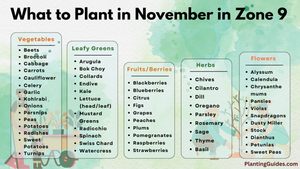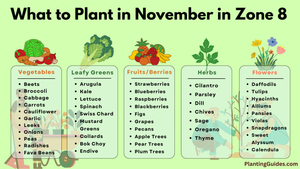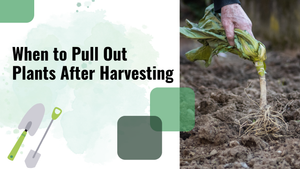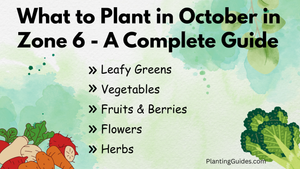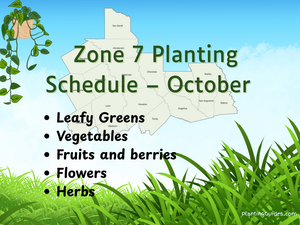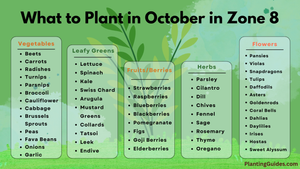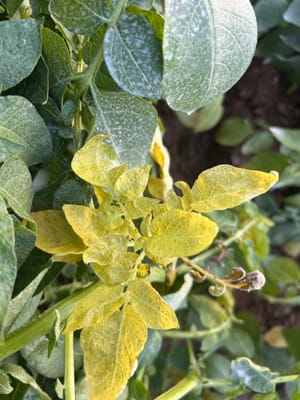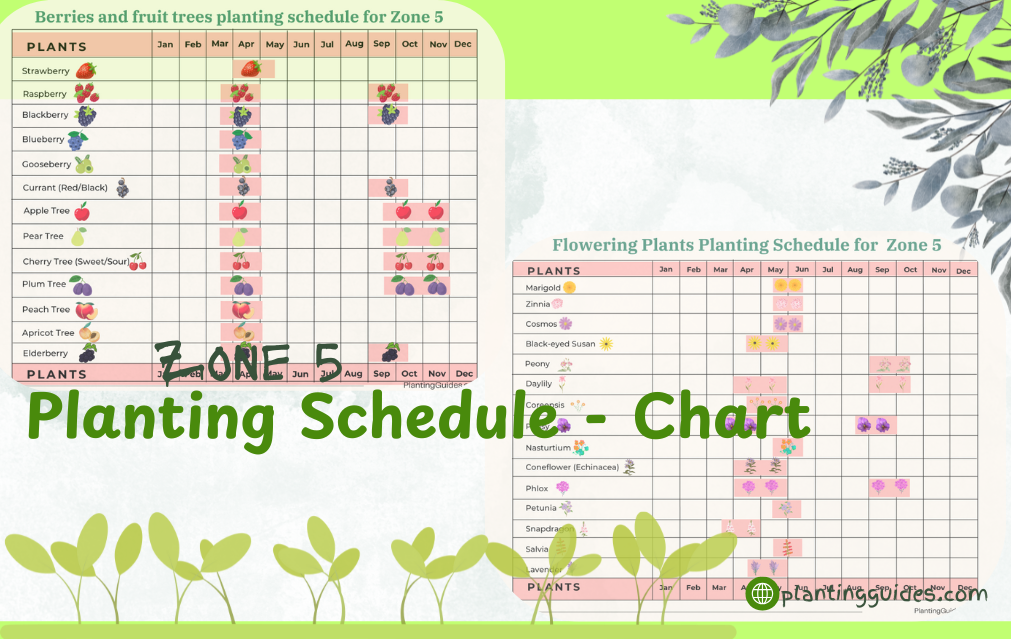
The secret behind a successful gardener is planting a plant at the right time of the year. I have created a complete planting calendar for zone 5. These planting schedule charts include the best planting time along with other necessary information.
This planting chart contains the following types of plants:
- Vegetables & Leafy Greens
- Herbs
- Flowering Plants
- Berries and fruit trees
All the planting times mentioned in my Zone 5 planting schedule chart are totally based on my personal experiences. A few of my friends have also in gardening for a long time and they cross-checked the chart for better accuracy.
The USDA hardiness zone 5 has a medium length growing season. It generally remains frost-free from May to October. But it is always recommended to keep an eye on your local weather updates for the first and last frost dates.
I have received a lot of requests from my regular readers to make a printable version of these charts. You can now get the printable planting schedule chart (nice and clean) from the link below:
Zone 5 Planting Schedule - Charts (Printable PDF version)
I know it's not difficult to check the planting times from this article. It took a lot of time and effort to make these visual charts. If possible, get the printable version to help me bring more content like this. This really motivates me.
The average minimum temperature in zone 5 is between -20°F and -10°F. This hardiness zone is comparably colder than many other regions of the United States, so I always recommend starting your seeds indoors.
Vegetables & Leafy Greens - Zone 5
In the following chart, you can find some of the vegetables and leafy greens with their planting time:
| Plant Name | Planting Time (Date Ranges) | Planting Method | Harvesting Time (Days) |
|---|---|---|---|
| Spinach | Mar 15 - Apr 15 Aug 15 - Sep 15 |
Direct Sow | 40-50 days |
| Kale | Mar 15 - Apr 30 Aug 1 - Sep 15 |
Direct Sow or Transplant | 50-65 days |
| Lettuce | Mar 15 - May 1 Aug 15 - Sep 30 |
Direct Sow or Transplant | 45-60 days |
| Swiss Chard | Apr 1 - May 15 Aug 1 - Sep 15 |
Direct Sow | 50-60 days |
| Collard Greens | Mar 15 - May 1 Aug 1 - Sep 15 |
Direct Sow or Transplant | 60-75 days |
| Arugula | Mar 15 - Apr 30 Aug 15 - Sep 30 |
Direct Sow | 35-45 days |
| Radish | Mar 15 - May 15 Aug 15 - Sep 30 |
Direct Sow | 20-30 days |
| Carrots | Apr 1 - May 30 Jul 15 - Aug 15 |
Direct Sow | 60-80 days |
| Beets | Apr 1 - May 30 Jul 15 - Aug 15 |
Direct Sow | 50-65 days |
| Peas | Mar 15 - Apr 30 | Direct Sow | 50-70 days |
| Broccoli | Mar 15 - Apr 30 (Transplant) Jul 15 - Aug 15 (Transplant) |
Transplant | 60-80 days |
| Cabbage | Mar 15 - Apr 30 (Transplant) Jul 15 - Aug 15 (Transplant) |
Transplant | 70-90 days |
| Bok Choy | Mar 15 - Apr 30 Aug 1 - Sep 15 |
Direct Sow or Transplant | 45-60 days |
| Turnips | Apr 1 - May 30 Aug 1 - Sep 15 |
Direct Sow | 40-60 days |
| Mustard Greens | Mar 15 - Apr 30 Aug 15 - Sep 30 |
Direct Sow | 40-50 days |
Visual Chart:
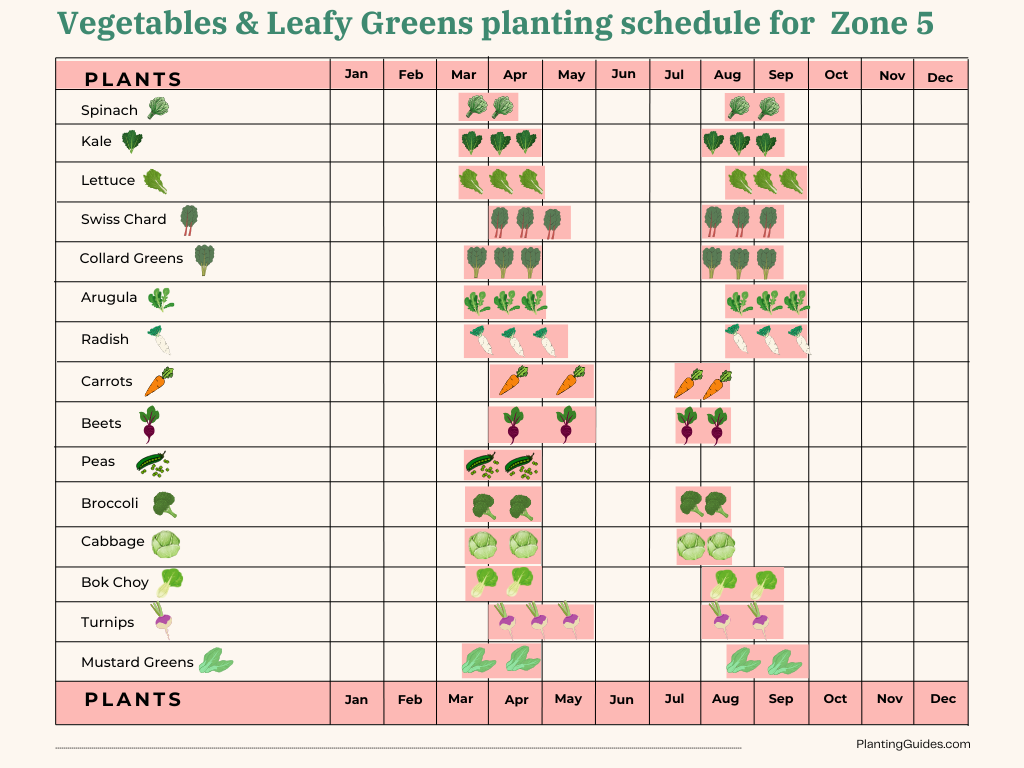
In my chart, I have used two planting date ranges for some specific plants, as we can grow them twice in a year.
Due to the rise in temperature, some of the vegetables may taste bitter. Try to follow my planting times to avoid that awkward taste.
I want to make gardening easy for you. This is why I have created a guideline for improving soil quality for vegetables.
Each plant has its own nutrient requirements. This will be helpful for you: make your own organic compost at home.
Herbs
Hardiness zone 5 gives you an opportunity to grow various types of herbs, as shown in the chart below, with planting time and planting methods:
| Herb Name | Planting Time (Date Ranges) | Planting Method | Harvesting Time (Days) |
|---|---|---|---|
| Parsley | Apr 1 - May 15 Jul 15 - Aug 15 |
Direct Sow or Transplant | 70-90 days |
| Basil | May 15 - Jun 15 (Transplant) | Transplant | 60-80 days |
| Cilantro | Apr 1 - May 15 Aug 15 - Sep 15 |
Direct Sow | 50-60 days |
| Dill | Apr 15 - May 30 | Direct Sow | 60-70 days |
| Chives | Mar 15 - May 1 | Direct Sow or Transplant | 60-80 days |
| Oregano | Apr 15 - May 30 (Transplant) | Transplant | 80-90 days |
| Thyme | Apr 15 - May 30 (Transplant) | Transplant | 90-120 days |
| Mint | Apr 1 - May 15 | Transplant | 60-90 days |
| Sage | Apr 15 - May 30 (Transplant) | Transplant | 90-120 days |
| Rosemary | May 15 - Jun 15 (Transplant) | Transplant | 90-120 days |
| Tarragon | Apr 15 - May 30 (Transplant) | Transplant | 90-110 days |
| Chervil | Mar 15 - Apr 30 Aug 15 - Sep 15 |
Direct Sow | 60-70 days |
| Lovage | Apr 1 - May 15 | Direct Sow or Transplant | 90-120 days |
Visual Chart:
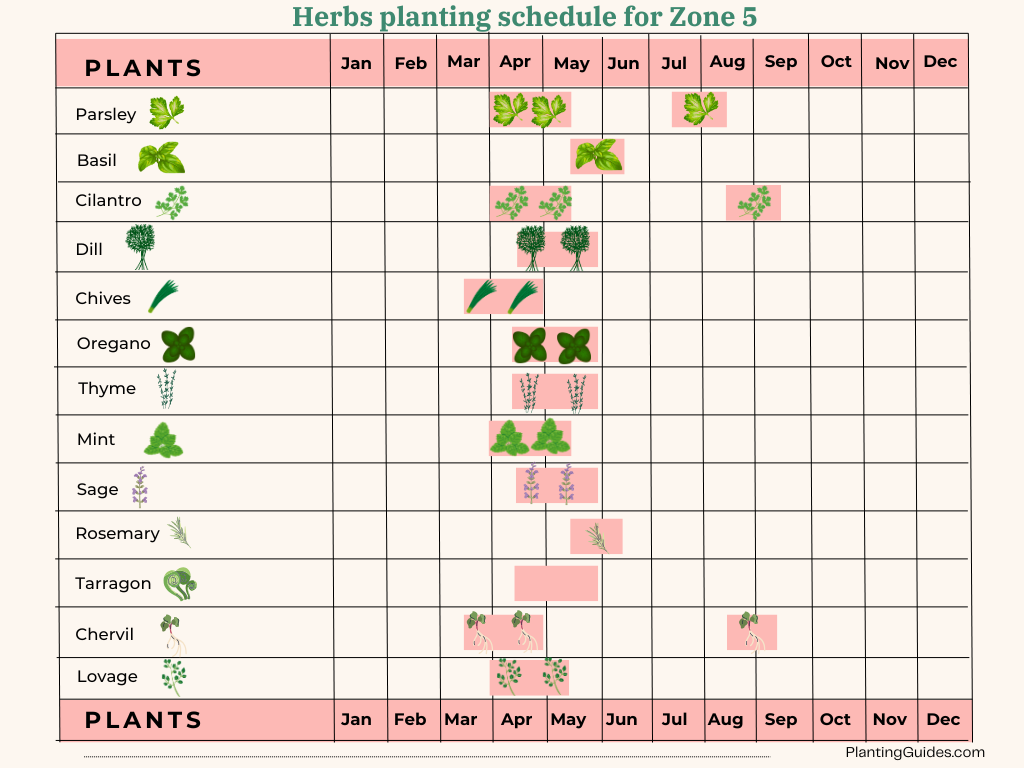
Note: Basil loves a warm climate, so try to plant them in summer.
I love herbs as they don't take much space in my garden, but the benefits are high. Some of the herbs act as natural pest repellents.
In one of my previous articles, I explained how to get rid of pests organically.
Flowering Plants - Zone 5 Planting Schedule
| Plant Name | Planting Time (Date Ranges) | Planting Method | Time to Bloom (Days) |
|---|---|---|---|
| Marigold | May 15 - Jun 15 | Direct Sow or Transplant | 45-60 days |
| Zinnia | May 15 - Jun 15 | Direct Sow | 60-75 days |
| Cosmos | May 15 - Jun 15 | Direct Sow | 70-90 days |
| Black-eyed Susan | Apr 15 - May 30 (Perennial) | Transplant or Direct Sow | 90-120 days (First Year) |
| Peony | Sep 1 - Oct 15 (Perennial) | Transplant (Root Divisions) | 365-730 days (Blooms Next Season) |
| Daylily | Apr 1 - May 30 or Sep 1 - Oct 15 (Perennial) | Transplant | 90-120 days (First Year) |
| Coreopsis | Apr 15 - May 30 (Perennial) | Direct Sow or Transplant | 70-90 days |
| Pansy | Mar 15 - Apr 30 Aug 15 - Sep 30 |
Transplant | 60-80 days |
| Nasturtium | May 15 - Jun 15 | Direct Sow | 50-60 days |
| Coneflower (Echinacea) | Apr 1 - May 30 (Perennial) | Transplant or Direct Sow | 90-120 days (First Year) |
| Phlox | Apr 1 - May 30 or Sep 1 - Oct 15 (Perennial) | Transplant | 90-120 days |
| Petunia | May 15 - Jun 15 | Transplant | 60-80 days |
| Snapdragon | Mar 15 - Apr 30 (Transplant) | Transplant | 70-90 days |
| Salvia | May 15 - Jun 15 | Transplant | 70-90 days |
| Lavender | Apr 15 - May 30 (Perennial) | Transplant | 90-120 days (First Year) |
Visual Chart:
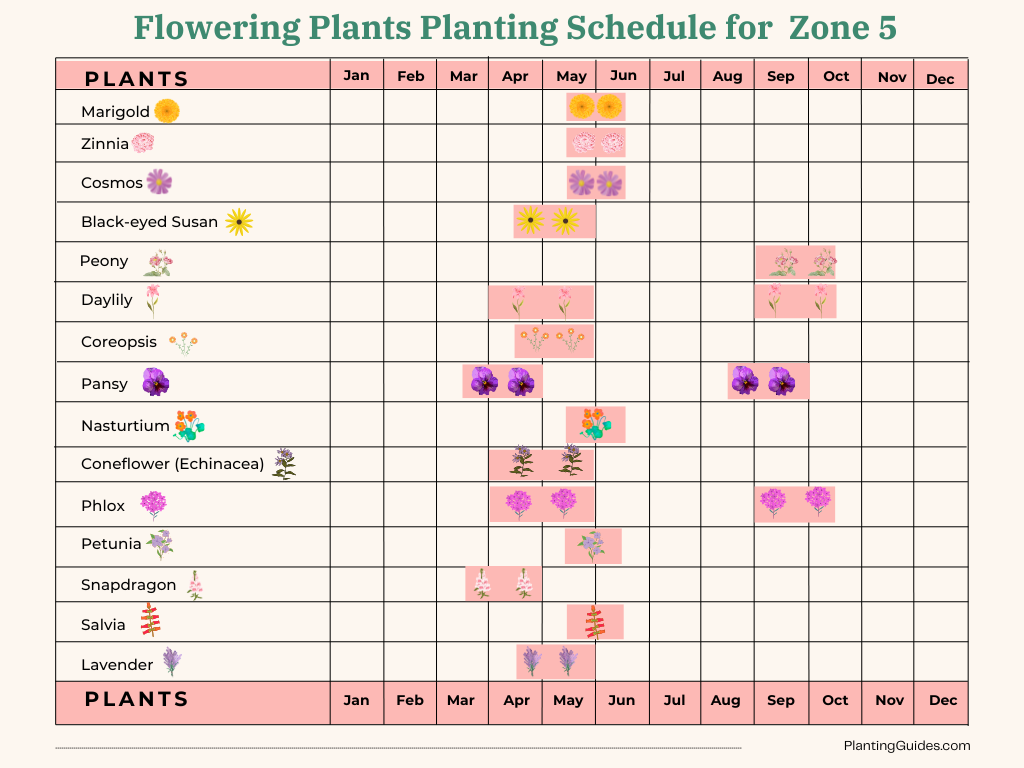
If you are growing vegetables in your garden, pollinators are very important.
These flowers, especially zinnia, attract a lot of pollinators in our garden.
Berries and fruit trees
If you are willing to plant berries of fruit trees, you need to know the proper planting time, otherwise, all your work will go in vain. Here is the appropriate planting schedule for fruits and berries for zone 9:
| Plant Name | Planting Time (Date Ranges) | Planting Method | Time to First Fruit |
|---|---|---|---|
| Strawberry | Apr 1 - May 15 | Transplant | 60-90 days (June-bearing); 30-60 days (Everbearing) |
| Raspberry | Mar 15 - May 1 or Sep 1 - Oct 15 | Transplant (Bare-root or Potted) | 1-2 years |
| Blackberry | Mar 15 - May 1 or Sep 1 - Oct 15 | Transplant (Bare-root or Potted) | 1-2 years |
| Blueberry | Mar 15 - May 1 or Sep 1 - Oct 15 | Transplant (Potted) | 2-3 years |
| Gooseberry | Mar 15 - May 1 | Transplant (Bare-root or Potted) | 1-2 years |
| Currant (Red/Black) | Mar 15 - May 1 or Sep 1 - Oct 15 | Transplant (Bare-root or Potted) | 1-2 years |
| Apple Tree | Mar 15 - May 1 or Sep 15 - Nov 1 | Transplant (Bare-root or Potted) | 3-5 years |
| Pear Tree | Mar 15 - May 1 or Sep 15 - Nov 1 | Transplant (Bare-root or Potted) | 3-5 years |
| Cherry Tree (Sweet/Sour) | Mar 15 - May 1 or Sep 15 - Nov 1 | Transplant (Bare-root or Potted) | 3-5 years |
| Plum Tree | Mar 15 - May 1 or Sep 15 - Nov 1 | Transplant (Bare-root or Potted) | 3-5 years |
| Peach Tree | Mar 15 - May 1 | Transplant (Bare-root or Potted) | 2-4 years |
| Apricot Tree | Mar 15 - May 1 | Transplant (Bare-root or Potted) | 2-4 years |
| Elderberry | Mar 15 - May 1 or Sep 1 - Oct 15 | Transplant (Bare-root or Potted) | 2-3 years |
Visual Chart:
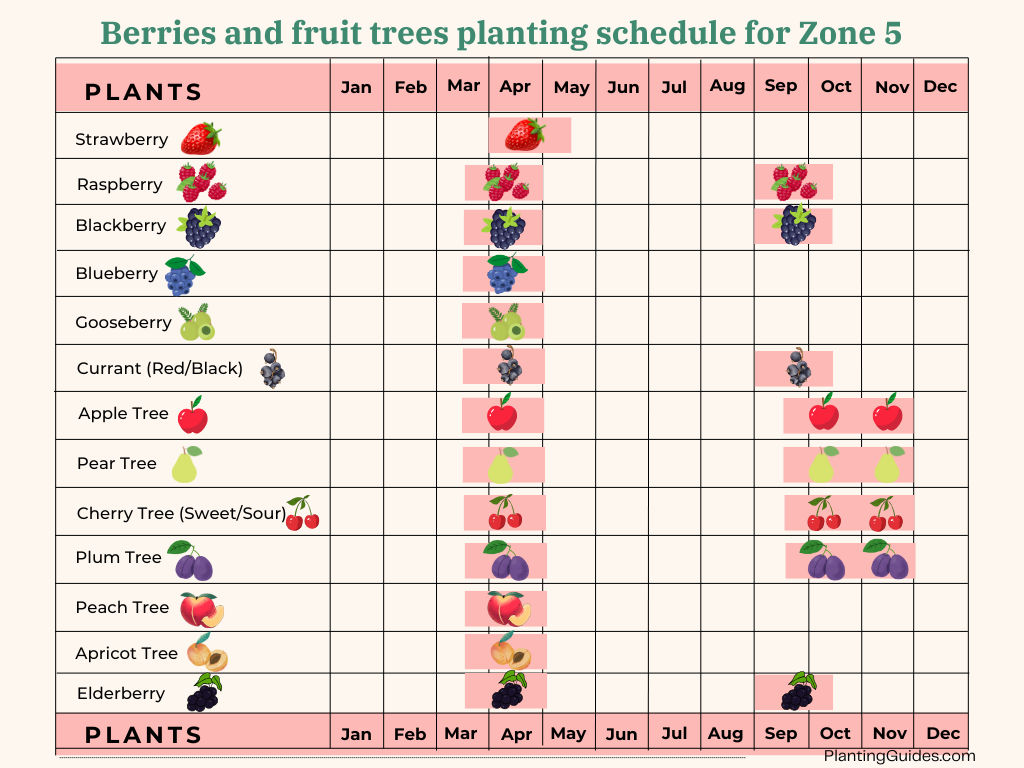
If you want the planting schedule chart in a Printable PDF format, feel free to contact me.
It took more than a month to build the visual charts. If possible, subscribe to this site and share with other Zone 5 gardeners.
